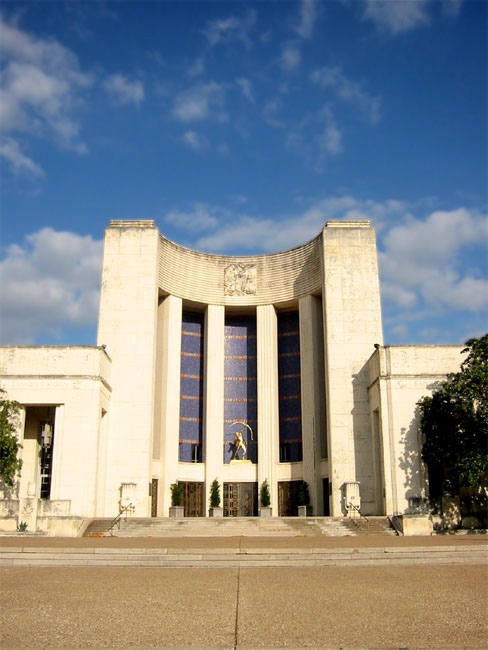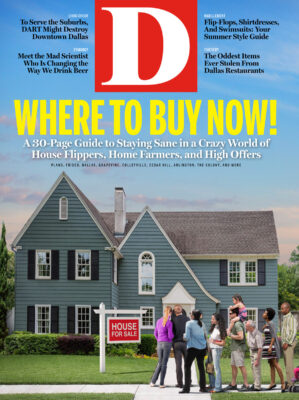Regionalism has been the dominant religion of Dallas since J. Erik Jonsson became mayor, in 1964. And thank God for it. By preaching the gospel, Dallas leaders brought growth and wealth to a flat, unappealing piece of America to an extent that still causes wonder and even—as with the “$5 Billion Mile” in Frisco—awe.
But regionalism has outlived its usefulness, at least as far as the residents of Dallas are concerned. The people who actually pay the taxes that made it possible are starting to feel like they have been played. Bad streets, crumbling infrastructure, congestion, pollution, and a collapse in the city’s median household income are too apparent to ignore. Millennials and baby boomers moving back into the city demand amenities designed for them, not for the suburbanites to whom Dallas City Hall has traditionally catered.
After his election, Mike Rawlings famously proclaimed himself the “Mayor of DFW,” a self-designation that may have surprised the voters of Plano, Frisco, and Southlake, not to mention his own citizens. The next mayor will run and win on an entirely different platform by announcing a new policy of putting Dallas first.
The regionalists—entrenched in the bureaucracy and in old-line institutions like the Dallas Citizens Council and the State Fair board—will fight tooth and nail. Changes in religion are never easy, and evidence has little impact on ideology. But it will be a rearguard action, and over the next decade they will lose every battle. Look at today’s controversies, and the outlines of the Dallas of tomorrow become clear.
The Trinity toll road.
The regionalists want it as a traffic reliever. Evidence shows it won’t be. They want it anyway. Pro-city advocates say the park should come first, with a road only to serve it (see Angela Hunt’s essay on p.42). The toll road is for suburbanites. The park is for residents. Private polls show Dallas citizens overwhelmingly oppose the toll road. National studies show that running highways through cities has been a major cause of urban poverty, pollution, and congestion. That anyone still supports the toll road at all shows just how deep religion can go—or how vested interests such as the engineering, concrete, and road-building industries still control the city’s agenda. The next mayor will win by promising voters that the Trinity toll road will never be built.
Replacing I-345 with a mixed-use neighborhood.
Instead of building new highways, pro-city advocates want to tear down and replace old ones that have divided neighborhoods, displaced thousands of people and hundreds of businesses, and contributed to poverty and blight. Regionalists say people need I-345 to get from Duncanville to their jobs in Allen. Pro-city advocates want to bring the people, the money, and the jobs back to Dallas. A new neighborhood would bring $4 billion to $5 billion in value to the city’s tax rolls and produce more than 10,000 jobs. Most important of all, it would bring 25,000 more people to the urban core, with the result that restaurants, dry cleaners, and salons would spring up to serve South Dallas. There is nothing wrong with DISD that a few thousand new middle-class mothers would not solve. And these new residents would have clout at City Hall to finally get something done about our city’s most precious and ruined asset, Fair Park.
By leveraging the new realized value of land that is now essentially worthless, Dallas will be able to reroute I-30 away from its core, eliminating the canyon that now divides downtown Dallas and opening up South Dallas for major growth. The estimated value of the resulting development is $16 billion to more than $20 billion.
Fair Park.
The regionalists support spiffing up the buildings but doing nothing to change its overall character as a once-in-a-while, paved-over North Texas entertainment venue. The pro-city advocates want a real park that can be enjoyed year-round by the neighborhoods around it. The State Fair, which has proven itself to be a self-dealing economic albatross around the city’s neck, will oppose even the merest suggestion that residents should come first. A private corporation, the State Fair will spend whatever it takes to keep the status quo. East Dallas residents have the leverage that their neighbors in South Dallas don’t. Once they realize Fair Park could be the crown jewel of East Dallas amenities, the battle will be over.
The new DART downtown line.
DART officials openly state that the objective is to move people from Irving to Plano. So they are trying to finance bigger stations downtown to handle longer trains, which only makes downtown more pedestrian-unfriendly than it already is. Pro-city advocates want an underground line and more attention to how DART can help, rather than impede, downtown residential growth (see Peter Simek’s article on p.132).
None of these battles will be easily won. Bureaucracies like DART and Dallas City Hall resist change. People like the State Fair executives, whose livelihoods are at stake, do not just fade quietly into the night. Crony capitalists whose entire net worth is dependent on federal and state highway dollars will not surrender without a fight. But the handwriting is on the wall. The demographic tide has shifted. The evidence from 20 years of research is clear. The regionalism that created wealth for many has wreaked untold damage on the city that spawned it.
Change is coming. The next Dallas mayor will be its leader.






